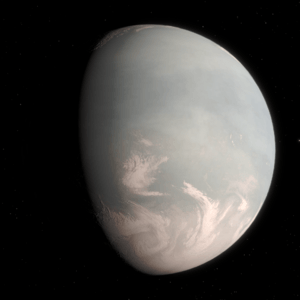Gliese 832 c facts for kids

An artist's impression of Gliese 832 c.
|
|
| Orbital characteristics | |
|---|---|
| 0.162 (± 0.017) AU | |
| Eccentricity | 0.18 (± 0.13) |
| 35.68 (± 0.03) d | |
| Star | Gliese 832 |
| Physical characteristics | |
| Mass | ≥5.4 (± 1) M⊕ |
Gliese 832 c (also known as Gl 832 c or GJ 832 c) was a candidate exoplanet located 16.2 light-years (4.97 parsecs) away in the constellation of Grus, orbiting the star Gliese 832, a red dwarf. The existence of the planet was refuted in 2022, when a study found that the radial velocity signal shows characteristics of a signal originating from stellar activity, and not from a planet.
It was thought to be in its star's habitable zone and to receive about the same amount of solar flux as Earth. The planet was thought to have a minimum mass of 5.4 Earth masses.
Contents
Characteristics
Mass, radius, and temperature
Gliese 832 c was thought to have a minimum mass of approximately 5.4 times that of Earth. If it had the same density as Earth, it would have a radius of around 1.75 R⊕. The planet was thought to have a relatively high eccentricity, taking it very near to the predicted inner edge of the habitable zone. The planet's average equilibrium temperature was predicted to be 253 kelvins (−20 °C), but was estimated to vary from 233 kelvins (−40 °C) at aphelion to 280 kelvins (7 °C) at perihelion. However, because of its large mass, it may have a dense atmosphere, which could make it much hotter and more like the planet Venus, or a mini-Neptune.
Host star
The planet orbits an M-type star named Gliese 832, which has one other known planet. The star has a mass of 0.45 M☉ and a radius of 0.48 R☉. It has a temperature of 3620 K and is estimated to be about 9.54 billion years old. In comparison, the Sun is 4.6 billion years old and has a temperature of 5778 K.
The star's apparent magnitude, or how bright it appears from Earth's perspective, is 10.19. Therefore, it is too dim to be seen with the naked eye. It is of spectral class M2V.
Orbit
The planet was thought to orbit its host star with about 3% of the Sun's luminosity approximately every 36 days, 10 times shorter than Earth's year, and an orbital radius 0.162 times that of Earth (compared to Mercury's orbital distance of 0.389 AU).
Habitability
The planet is a super-Earth mass planet orbiting in its star's habitable zone. Although it orbits its star much closer than the Earth orbits the Sun, it orbits a red dwarf, receiving approximately as much energy from it as the Earth does from its star. It is not known whether Gliese 832 c transits its host star, something which would be required in order to detect any atmosphere the planet may have and determine its composition.
Its host star (Gliese 832) has 45% of the Sun's mass, and as a result, stars like Gliese 832 have the ability to live up to 50–60 billion years, 5–6 times longer than the Sun will live.
The planet is likely tidally locked, with one side of its hemisphere permanently facing towards the star, while the opposite side shrouded in eternal darkness. However, between these two intense areas, there would be a sliver of habitability – called the terminator line, where the temperatures may be suitable (about 273 K (0 °C; 32 °F)) for liquid water to exist. Additionally, a much larger portion of the planet may be habitable if it supports a thick enough atmosphere to transfer heat to the side facing away from the star.
In the case that Gliese 832 c possesses a Venusian-like atmosphere, which it could have due to its eccentric orbit (and the stellar flux reaching 1.45 S🜨, high enough to boil any oceans on its surface), the planet would be inhospitable because of a runaway greenhouse effect on its surface. Any oceans on its surface would have boiled away due to the dense atmosphere, and as this occurred, the temperature would have risen to around 322 K (49 °C; 120 °F). The water vapor would accumulate in the atmosphere to the point where the surface temperature would rise to around 700 K (427 °C; 800 °F) as the planet would have been overwhelmed by water vapor (which is a powerful greenhouse gas). Little amounts of carbon dioxide would have been present, as Gliese 832 c was/is probably an ocean planet. The surface pressure would have also increased to around 100 times Earth's surface pressure (100 kilopascals, 100 atm.) because of the amount of water vapor in the atmosphere. The net result would be that Gliese 832 c being a desert planet, rather than an ocean planet.
Discovery and impact
Gliese 832 c was discovered in 2014 by an international team of astronomers led by Robert A. Wittenmyer. It was at the time the newest and closest to earth member of the top three most Earth-like worlds in the Habitable Exoplanets Catalog, but was removed from the catalog in 2022 following its refutation. The planet's discoverers described the planet as "the nearest best habitable world candidate so far". Further research may be done on Gliese 832 c to see if it is suitable for life.
Doubts were raised about the existence of Gliese 832 c by a 2015 study, which found that its orbital period is close to the stellar rotation period. The existence of the planet was refuted in 2022, when a study confirmed that the radial velocity signal shows characteristics of a signal originating from stellar activity, and not from a planet. This is similar to claims of super-Earths in the habitable zones of other red dwarfs, such as Gliese 581 and Kapteyn's Star, that were later disproven.
See also

